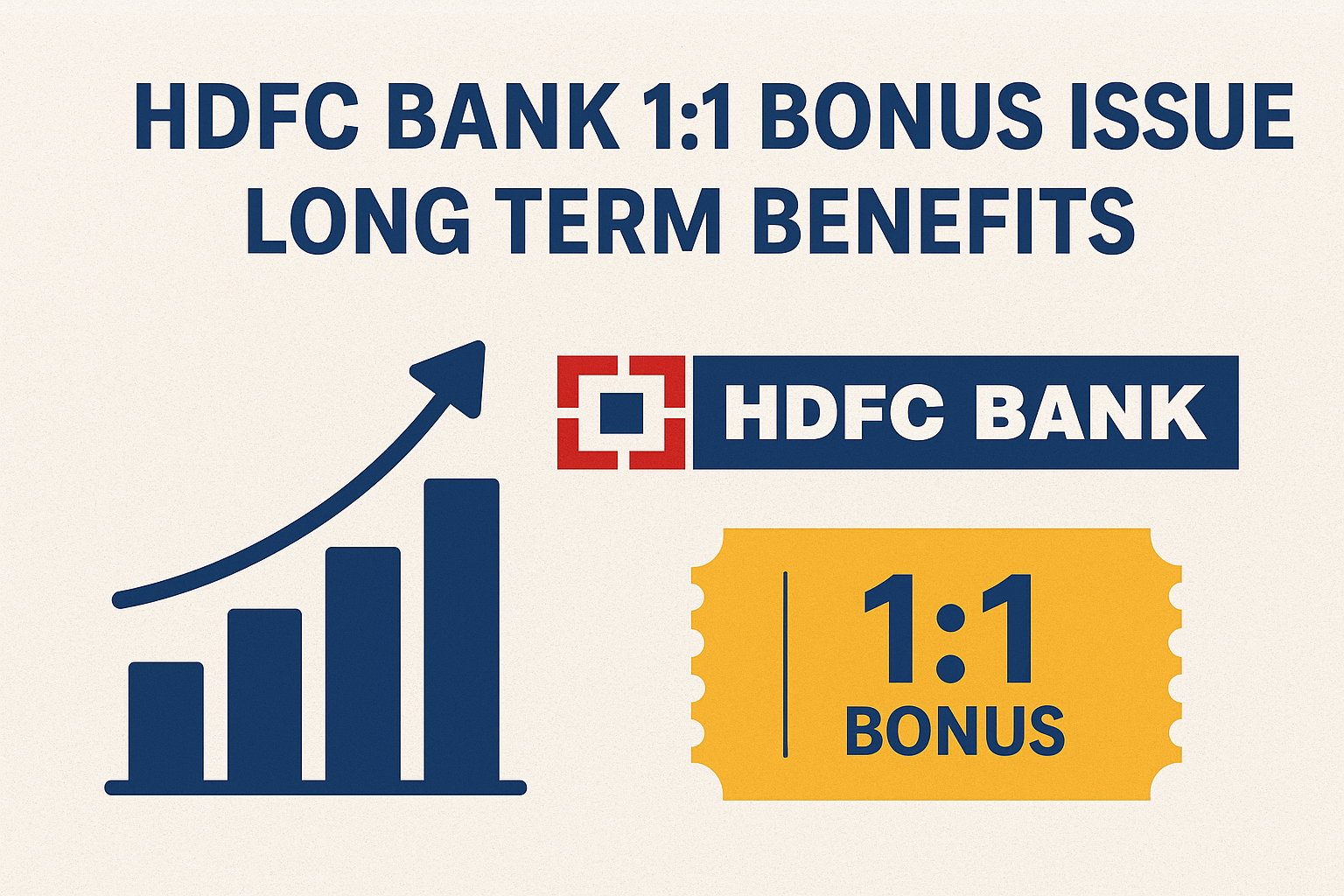HDFC Bank’s announcement of its first-ever 1:1 bonus issue has become a hot topic—especially as the stock appeared to plunge over 50–60% when it went ex-bonus on August 26, 2025. But this sharp dip was purely technical, not a reflection of any financial distress. For long-term investors, the HDFC Bank 1:1 bonus issue long term benefits lie far beyond the initial drop—it’s a strategic move with favorable implications for equity-holding strategy, liquidity, and overall shareholder value.
What Happened on August 26, 2025?
-
On August 26, 2025, HDFC Bank shares began trading ex-bonus, following the record date for its 1:1 bonus issue
-
The share price halved—visually a 50–62% “crash”—because each shareholder received an additional share for every share held. This doubled the share count but halved the price per share, keeping the market cap and total value unchanged
-
The ostensible “drop” was a technical adjustment, not a sign of weakening fundamentals
Why Issuing a Bonus Matters: The Long-Term Strategic Advantage
1. Amplified Liquidity & Affordability
By halving the share price, the stock becomes more affordable to a wider pool of investors, thereby improving trading volume and market liquidity. Institutional brokers and retail investors alike benefit from better float and easier entry points
2. Strengthens Investor Sentiment
A bonus issue signals confidence from management—it’s a way of rewarding existing shareholders without cash outflow. Coupled with HDFC Bank’s declaration of a special ₹5 dividend per share, it reflects a shareholder-friendly capital approach.
3. Enhanced Portfolio Dynamics Over Time
For long-term equity strategy, investors see their share counts double while the effective price halves—keeping portfolio value intact initially, but providing greater flexibility for diversification, SIPs, and rebalancing over time.
4. Favorable Tax Implications (With Planning)
According to Mint, bonus shares are taxed:
-
Within 1 year: 20% Short-Term Capital Gains (STCG) applied on entire sale value.
-
After 1 year: 12.5% Long-Term Capital Gains (LTCG) on gains exceeding ₹1.25 lakh .
For retail investors planning to hold for over a year, the LTCG scenario is more favorable, making the HDFC Bank 1:1 bonus issue long term benefits especially relevant.
5. Strong Fundamentals Support the Move
Q1 FY26 results reinforce confidence. HDFC Bank’s standalone net profit rose ~12% YoY, with NII up 5.4%, and asset quality remained strong with gross NPA at 1.40% and net at 0.47%. Capital adequacy stood at a healthy 19.9%
6. Structural Adjustments in Trading & Derivatives
Margin trading (MTF), Shares-as-Margin (SAM), and F&O positions experienced temporary restrictions on ex-date. Adjustments to strike prices, lot sizes, and premiums were made to ensure smooth continuity—e.g., options lot size doubled, strike price halved.
Long-Term Equity Share Strategy: What Should Investors Do?
1. View with Patience
The initial price adjustment is cosmetic. For long term, the doubling of share count offers more composite value and flexibility.
2. Plan Around Tax Strategy
Holding bonus shares beyond one year can greatly improve post-tax outcomes. Thus, a planned long-term horizon >12 months is optimal.
3. Leverage Improved Liquidity
Use the enhanced market participation as an opportunity to scale into positions, especially after an ex-bonus dip often attracts bargain interest.
4. Review and Rebalance
The increased number of shares means you can reallocate portions to diversify or capitalize on other market opportunities, while staying invested in HDFC Bank.
5. Monitor Fundamentals
Existing strong earnings, asset quality, and capital ratios continue to underpin the case for HDFC Bank as a solid compounding story
Psychological Edge for Retail Investors
When the share price gets halved due to a bonus, it appears “cheaper” to the retail eye. Even though the valuation hasn’t changed, the psychological affordability draws in more small investors—helping long-term holders by boosting demand over time.
Compounding Benefits Through Dividends
With more shares in hand after the bonus issue, investors receive dividends on a larger quantity—even if per-share dividend remains the same. Over a 10–15 year horizon, this accelerates compounding of passive income.
Market Depth and Index Representation
A wider base of shareholders increases market depth. For a bank like HDFC, which is already a heavyweight in Nifty and Sensex, this enhances its role in passive index funds and ETFs, driving steady institutional inflows.
Improved Corporate Image and Investor Trust
A bonus issue reflects management’s confidence in sustainable growth. This improves HDFC Bank’s brand in the equity market, potentially making it the preferred choice for conservative long-term investors who equate bonus issues with stability.
Exit Flexibility in Volatile Times
Having double the shares gives investors more granular flexibility. Instead of selling one large share at a higher price, holders can trim smaller quantities post-bonus to manage liquidity needs without disrupting long-term compounding.
Favorable for SIP Investors in Stocks
For those doing SIPs in HDFC Bank shares, the post-bonus lower price per share makes systematic buying more efficient, leading to higher share accumulation at the same investment amount.
Corporate Governance Signal
Bonus issues are often interpreted as signals of good corporate governance—the company prefers to share accumulated reserves in the form of equity expansion, which indicates transparency and accountability.
Historical Pattern of Wealth Creation
In Indian markets, large, fundamentally strong companies (like Infosys, TCS, Asian Paints) that issued multiple bonuses have created immense wealth over decades. HDFC Bank’s first bonus issue may be the beginning of a similar wealth-building journey for its investors.
Portfolio Visibility for Generational Wealth Transfer
Since shares double in quantity, distributing them across family portfolios or passing them on as inheritance becomes smoother. It helps in wealth transfer planning, especially for investors looking at inter-generational equity strategies.
Easier Access for Option Writers & Traders
Post-bonus, the lower strike prices and adjusted lot sizes make it easier for derivatives traders to participate. This expands trading interest, which indirectly supports long-term liquidity and stability in the stock.
Conclusion
The HDFC Bank 1:1 bonus issue long term benefits lie in its ability to enhance liquidity, broaden affordability, reward shareholders, and reinforce investor confidence—while preserving capital value. When combined with robust fundamentals and careful tax and strategy planning, this bonus move can unlock powerful compounding potential for patient investors.
![]()



